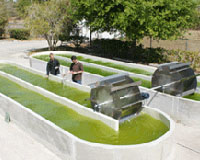 |
Riverside CA (SPX) Nov 04, 2009 A team of researchers led by University of California, Riverside (UCR) Professor of Chemical Engineering Wilfred Chen has constructed for the first time a synthetic cellulosome in yeast, which is much more ethanol-tolerant than the bacteria in which these structures are normally found. The yeast cellulosome could enable efficient one-step "consolidated bioprocessing" by maximizing the catalytic efficiency of cellulosic hydrolysis with simultaneous fermentation. The process of using these engineered yeasts can potentially make the production of bioethanol from biomass more efficient and economical. The federal Energy Policy Act mandates the increased production of renewable fuel, such as bioethanol created from biomass. Currently, the most common method of producing bioethanol uses sugar cane and corn starch. Efficient, cost-effective methods of using non-food related materials like cellulosic biomass found in agricultural and wood-pulping wastes is the focus of new research by Chen's team, among others. The use of multiple enzymes in the cellulosome greatly increases the efficiency of hydrolysis because heterogeneous forms of cellulose can be digested. The artificial cellulosome developed at UCR is highly modular and can be engineered to display ten or more different cellulases, the composition of which can be tuned to optimized hydrolysis of any feedstock. Cellulosomes are self-assembled structures found on the exterior of certain bacteria that allow the organisms to efficiently break down cellulose. The cellulosome contains multiple types of cellulases (enzymes that break down cellulose), optimally spaced for maximum activity. The experimental cellulosome contains three different cellulases. Yeast engineered with this triple cellulase cellulosome was able to multiply to high levels with cellulose as the only carbon source. Compared to controls engineered with one or two cellulases, the triple cellulase displaying yeast had higher rates of hydrolysis, demonstrating the benefit of using diverse cellulytic enzymes in a single organism. The process is described in the paper "Functional Assembly of Minicellulosomes on the Saccharomyces cerevisiae Cell Surface for Cellulose Hydrolysis and Ethanol Production," in the American Society of Microbiology's journal Applied and Environmental Microbiology. The paper was co-authored by UCR students Shen-Long Tsai and Shailendra Singh, post-doctoral researcher Jeongseok Oh, and Ruizhen Chen, associate professor at the School of Chemical and Biomolecular Engineering at Georgia Institute of Technology. Share This Article With Planet Earth
Related Links University of California, Riverside (UCR) Bio Fuel Technology and Application News
 K-State Engineers Study Surface Texture And Algae Growth
K-State Engineers Study Surface Texture And Algae GrowthManhattan KS (SPX) Nov 04, 2009 Two Kansas State University engineers are assessing systematic production methods that could make the costs of algae oil production more reasonable, helping move the U.S. from fossil fuel dependency to renewable energy replacements. The idea by K-State's Wenqiao "Wayne" Yuan and Zhijian "Z.J." Pei is to grow algae in the ocean on very large, supporting platforms. The National Science Found ... read more |
|
| The content herein, unless otherwise known to be public domain, are Copyright 1995-2009 - SpaceDaily. AFP and UPI Wire Stories are copyright Agence France-Presse and United Press International. ESA Portal Reports are copyright European Space Agency. All NASA sourced material is public domain. Additional copyrights may apply in whole or part to other bona fide parties. Advertising does not imply endorsement,agreement or approval of any opinions, statements or information provided by SpaceDaily on any Web page published or hosted by SpaceDaily. Privacy Statement |